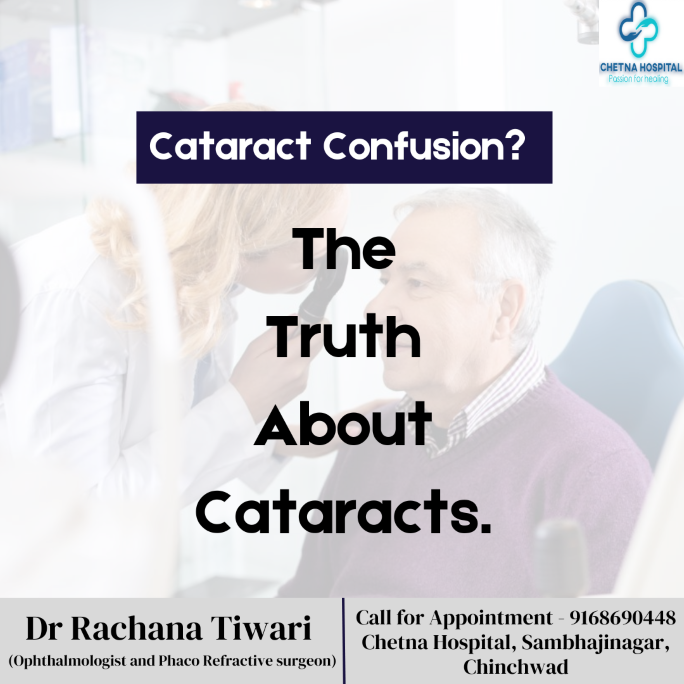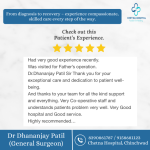Cataracts are one of the most common causes of vision impairment worldwide, especially among older adults. Yet, despite their prevalence, many myths and misconceptions persist about what cataracts are, how they develop, and how they are treated. In this comprehensive guide, we’ll debunk the most common myths and provide the facts you need to better understand this condition.
What Are Cataracts?
Before diving into the myths, it’s essential to understand what cataracts are. A cataract occurs when the lens of the eye, which is normally clear, becomes cloudy. This clouding affects vision and can make it difficult to see clearly, leading to blurred vision, glare sensitivity, and trouble with night vision. Cataracts typically develop slowly over time, and if left untreated, can cause significant vision impairment or even blindness.
Cataracts are primarily associated with aging, but they can also result from other factors such as eye injury, prolonged exposure to ultraviolet (UV) light, certain medications (like corticosteroids), and medical conditions such as diabetes. They can occur in one or both eyes and vary in severity.
Now, let’s debunk some of the common myths surrounding cataracts.
Myth 1: Cataracts only affect older people.
Fact: Cataracts can develop at any age.
While cataracts are indeed more common among people over the age of 60, they can develop at any age. There are several reasons why younger individuals might develop cataracts:
- Trauma: Eye injuries can lead to cataracts, sometimes developing immediately after the injury or even years later.
- Congenital Cataracts: Some babies are born with cataracts due to genetic factors or infections during pregnancy.
- Medical Conditions: Conditions like diabetes can cause cataracts to form at a younger age.
- Medications: Long-term use of corticosteroids and other drugs may increase the risk of cataracts.
In essence, while age is the most common cause of cataracts, younger individuals are not immune.
Myth 2: Cataracts need to be “ripe” before surgery can be performed.
Fact: Cataracts can be removed as soon as they interfere with daily activities.
In the past, cataracts were only removed once they became significantly advanced or “ripe,” leading to severe vision impairment. However, with advancements in cataract surgery techniques, it is now possible—and often recommended—to remove cataracts as soon as they begin to affect your quality of life. This can include difficulties with reading, driving (especially at night), or performing everyday tasks.
Waiting too long to have cataract surgery can make the procedure more difficult and increase the risk of complications, so it’s important to discuss options with your ophthalmologist early on.
Myth 3: Cataracts grow back after surgery.
Fact: Cataracts do not grow back, but a secondary cataract (PCO) can develop.
Once a cataract is removed, it does not return. However, a condition called posterior capsule opacification (PCO), sometimes referred to as a “secondary cataract,” can develop months or even years after cataract surgery. PCO occurs when the lens capsule, which holds the artificial lens implanted during surgery, becomes cloudy over time.
Fortunately, this condition is easily treatable with a quick, painless laser procedure called YAG laser capsulotomy. This outpatient treatment restores clear vision by creating a small opening in the cloudy capsule, allowing light to pass through to the retina.
Myth 4: Cataracts are preventable with glasses or eye drops.
Fact: Cataracts cannot be prevented with glasses or any medication.
There is no scientific evidence to support the claim that glasses, eye drops, or any medications can prevent or reverse cataracts. Cataracts are primarily caused by the natural aging process, and while factors like UV exposure and smoking can accelerate their development, there is no proven way to prevent them altogether.
Wearing sunglasses with UV protection, maintaining a healthy diet, and avoiding smoking can help reduce your risk, but these measures do not guarantee cataract prevention.
Myth 5: Cataract surgery is risky and painful.
Fact: Cataract surgery is a safe, quick, and virtually painless procedure.
Cataract surgery is one of the most commonly performed surgeries worldwide, with a success rate of over 95%. It is a minimally invasive procedure that usually lasts around 15-20 minutes. During the surgery, the cloudy lens is removed and replaced with an artificial intraocular lens (IOL).
Thanks to advancements in technology, most cataract surgeries are performed with local anesthesia, and patients experience little to no pain during the procedure. Recovery is usually quick, with most people resuming normal activities within a few days.
While all surgeries carry some level of risk, cataract surgery is considered highly safe, with a low complication rate. Common risks, such as infection or swelling, are rare and treatable.
Myth 6: Cataracts affect only one eye.
Fact: Cataracts often develop in both eyes, though not always at the same time.
It is common for cataracts to develop in both eyes, but one eye may be more affected than the other, or the cataracts may progress at different rates. This means that some people may initially notice vision problems in only one eye, but over time, both eyes will likely be affected.
It is important to monitor the vision in both eyes and consult with an ophthalmologist if any changes occur.
Myth 7: Only elderly people need cataract surgery.
Fact: Cataract surgery is necessary whenever cataracts interfere with vision, regardless of age.
As mentioned earlier, cataracts can develop at any age. The need for surgery is not determined by age but by the impact cataracts have on your vision and daily life. If cataracts are affecting your ability to drive, read, work, or enjoy activities, it’s time to discuss surgery with your doctor—whether you’re 40 or 80.
Myth 8: Cataracts are caused by overusing your eyes or straining them.
Fact: Cataracts are caused by the natural aging process, not by eye strain.
There is no connection between cataracts and eye strain or overuse. Cataracts form when proteins in the eye’s lens clump together and create cloudy areas. This is a natural process that occurs as we age, and other factors like UV exposure, genetics, and medical conditions (such as diabetes) may contribute.
Using your eyes frequently for reading, working on a computer, or watching TV does not cause cataracts. However, excessive screen time may lead to digital eye strain, which is a different issue altogether.
Myth 9: Cataracts can be cured with diet and vitamins.
Fact: While certain nutrients may support eye health, they cannot reverse cataracts.
Maintaining a healthy diet rich in antioxidants, vitamins, and minerals can help protect your eyes from damage caused by oxidative stress. Some studies suggest that nutrients such as Vitamin C, Vitamin E, lutein, and zeaxanthin may help reduce the risk of cataracts or slow their progression.
However, once a cataract has formed, no amount of dietary change or supplementation can reverse it. The only effective treatment for cataracts is surgical removal.
Myth 10: Cataract surgery is only for people with severe vision loss.
Fact: Cataract surgery is recommended when your cataracts affect your daily life, not just when vision is severely impaired.
You don’t need to wait until your vision is significantly affected to have cataract surgery. If cataracts are making it difficult to drive, read, or perform other daily activities, it’s time to consider surgery. Early intervention can improve your quality of life and prevent accidents or complications caused by poor vision.
Delaying surgery can also make cataracts more difficult to remove and increase the risk of complications, so it’s important to discuss the best timing for surgery with your ophthalmologist.
Myth 11: After cataract surgery, you won’t need glasses anymore.
Fact: Some people may still need glasses or contact lenses after cataract surgery.
While cataract surgery often improves vision significantly, it may not eliminate the need for glasses or contact lenses entirely. This depends on the type of intraocular lens (IOL) implanted during surgery. For example, monofocal lenses improve distance vision but may still require reading glasses for close-up tasks. Multifocal and toric lenses can reduce the need for glasses for both near and far vision but may not completely eliminate it.
Your ophthalmologist will discuss the best lens option for you based on your lifestyle and vision needs.
Conclusion: Clear the Myths, See the Facts
Cataracts are a common eye condition, but they don’t have to mean the end of clear vision. By debunking the myths surrounding cataracts, we hope to empower individuals to seek timely diagnosis and treatment.
Cataract surgery is a safe and effective way to restore vision and improve quality of life. If you’re experiencing symptoms or have concerns about your eye health, don’t let myths hold you back. Consult an ophthalmologist for an eye exam and get the facts about cataracts and your treatment options.
For Consultation Contact us on 9168690448
Website – www.chetnahospital.co.in
Address – Chetna Hospital, Sambhajinagar, MIDC, G Block, Near Rotary Club, Chinchwad 411019
.
.
.
#hospital#pune#pcmc#chinchwad#medical#medicalservices#dryeyetreatment#dryeyerelief#dryeyedisease#dryeyetherapy#catract#catractsurgery#catracteyesurgery#catracteyeoperation#eyedoctor#eye#glaucoma#conjunctivitis#ophthalmologist#eyediseases#eyepain#pinkeye#hazeleyes#myopia#eyeinfection#amblyopia#dryeyesyndrome#eyeproblems#motibindu#motibinduoperation













